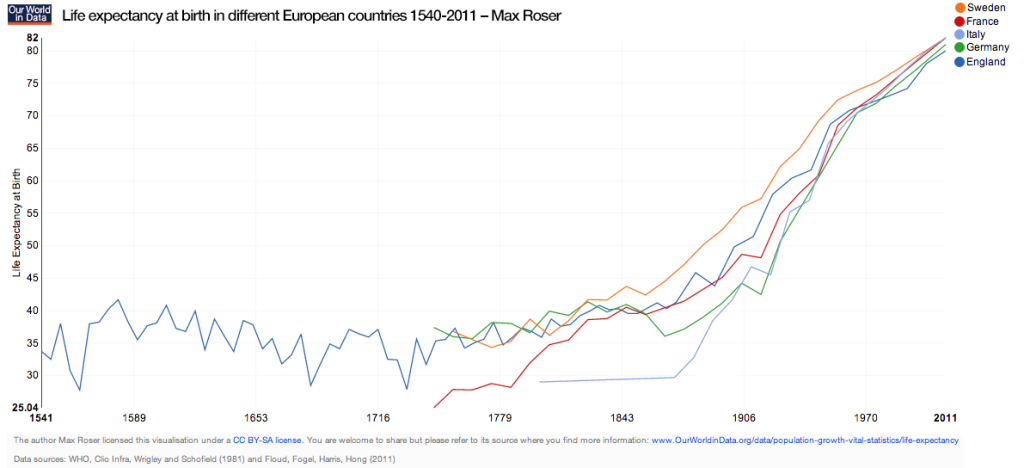LIFE EXTENSION
Every time I hear a story about the impacts of global warming, it mentions how it is the current generation’s grandkids’ problem. This is one of the things that makes the problem so hard to deal with.
Humans are terrible about thinking through the future beyond what will happen to us, and our imperative also seems to be one of selfishness—a “that’s not my problem” kind of mentality. This is the exact reason why, if people are going to live significantly longer, this all suddenly becomes their problem, and it suddenly becomes an important problem to solve.
As a futurist and longevity activist, I am constantly in the position of describing to older people the impact of life extension in the near future, and the conversation almost always follows the same course. Most people around 50 years or older, sadly, have already accepted (and come to terms with) their “impending” mortality. They don’t necessarily “want” to live longer and seem to accept the world as is.
But, as I continue to expand upon the ideas and theories of the future and coming medical advances, they start to see the possibility: Maybe they could live a radically longer life.
Once they check their reservations at the door, I can see their thought process start to change, a little light bulb goes off in their head, and they almost always inevitably say, “but the planet can’t handle that many people.”
Looking at the below image, you can understand why they think this way:

Now we are talking.
They suddenly actually care about the planet’s future, if only for a fleeting second when they think that they might live long enough to exist in it. Honestly, this is the moment I cherish most with these people, because I now know that they are thinking wholeheartedly about the possibility and maybe, for the first time, coming to terms with what is the most pressing issue of our time.
From here, I get to introduce the concept of Abundance as taught by Peter Diamandis and other futurists, that lays out a possible path for our continued existence on this planet.

The idea of abundance is a guiding and comforting theory of the future because it lays out a path where we will not all be starving or fighting over resources, but where we will be living in a society of plenty, one that has solved the majors problems that we have created by focusing our economic principles of society so strongly on scarcity.
I usually start explaining the theory by discussing energy as a root cause of our current situation. If we solve our energy scarcity problem, the energy can then be used to power the solutions that underlie almost all of our other problems.
Every day, enough solar energy falls on the world in a couple of hours to power us for the entire year. We are already actually tracking way ahead of almost every estimate on our amount of solar panel production and installation growth, and it seems to be speeding up due to exponential advances in technology.
As Elon Musk pointed out when launching the PowerWall, with today’s solar panels (20% efficient) it would only take an area of solar panels the size of a few counties in Northwest Texas to power all of the US, while an area of panels the size of Spain could power the entire world.
The secret weapon of solar panels is actually batteries, and even batteries without solar panels, as they can smooth the production curve from conventional sources. With a battery system, one can store the energy produced in the middle of the night when demand is low and shift that usage out from during the middle of the day when ACs are blasting at full speed, factories are in high-production and every office is lit up.
That said, if solar panels for some reason don’t generate enough energy, in the future we will very likely return to a form of nuclear power, which is fairly clean, especially if we are using thorium instead of plutonium.
Beyond that, we are working on some more “out there” technologies like actual fusion.
The biggest collaborative project in the world right now is something called ITER, also known as “a star in a bottle” and it is an amazing feat of engineering, that if it works, will create a giant spherical magnetic field, inside of which will be a form of self-perpetuating fusion that is millions of degrees hot and is basically a star.
And if that doesn’t work, we have many other technologies in progress. What is more important to me than the actual method we use to solve it, is what unlimited energy or a level near that, will allow for.
Well for starters, we can use that water to grow our food, but it also turns out that growing food outside may not actually be the best way to do it. Sunlight is transient, and even the best land in the world only gets 8-10 hours or so of desirable light per day, and then you have insects, parasites and a host of other shortcomings of traditional agriculture. Not to mention that most places are not ideal for growing food due to weather, topography, temperature, soil, etc. Farms are also generally not located near where people live, which causes logistical issues if the food will spoil, etc.
The solution, which is already being implemented today, is something called vertical farming.
The first large-scale vertical farm was launched in Japan near where the Fukushima nuclear reactor had caused significant radiation (I completely recognize the irony of this, based on my statements about nuclear power above). The project was meant to show that vertical farms can be used to grow food, even in inhospitable areas. And we actually see the next ones being installed in places where there are land shortages (Singapore) and where growing conditions are not desirable and/or traditional farming is impossible (Nepal & Tibet).
Vertical farming is pretty much exactly what it sounds like, growing food indoors and inside buildings where rows of plants can be stacked on top of each other. A single large building can grow food for the surrounding neighborhood, and it only has to travel mere feet to its destination.
The further benefits of vertical farming are that it takes significantly less water than conventional agriculture because the plants grow in an environment that has no soil, no bugs, and no evaporation. On top of that, using specially designed LEDs that have the specific wavelengths that plants need for growth (red and blue), they can simulate 12-18 hours of sunlight per day and grow plants much more rapidly.
The farm in Japan I mentioned above is growing over 10,000 heads of lettuce in 25,000 square feet, so it is 100x more productive than traditional farming, while using 80% less food waste, 40% less energy and 99% less water.
And mind you, this is all organic, no pesticide, and hyperlocal. It is truly the future of agriculture. Right now they can only grow leafy greens, but they are working on bigger and more hearty plants. These vertical farms are popping up all over the US and the largest one in the world is being built in New Jersey, just across from New York City.
So now that we have energy, water, and food taken care of, I will comment quickly on one of the other aspects that people mention, which is space on our planet.
So it turns out that most of the planet and the interior of the US is largely uninhabited by humans, and we actually have plenty of room, we just don’t utilize it. If everyone in the world lived at the same population density as Paris or New York, all 7-8 billion of us could actually fit in an area the size of Texas [Editor’s note: We obviously still need room for schools, hospitals, etc., but the primary point is that we aren’t using space efficiently).
We have plenty of room, and even though dense cities are much more efficient than the suburbs, we could build our homes in all of those areas. There are technologies here today, such as the 3D printing of entire apartment buildings and homes in mere hours or days. We can easily provide enough homes for anyone who wants them, and I imagine in the future we will print entire cities for those who do not have a place to live.
We should not live in a society where people have to live on the street and or go to bed hungry. We could solve these problems today if we actually tried, but we really do not put the resources or the right mentality towards it. This is something that will come naturally as we will run out of excuses to not do it and to look at ourselves in the mirror and wonder why we allow society to function in that way.
Energy, water, food, housing, are all taken care of, so what is next?
Well as of right now, the most pressing issue is what this article opened with: Climate change and the sustainability of our existence on the planet. We are really going to have to do something about it and fairly quickly. Global society seems, for the first time, to actually be trying to take some action to curb our warming effect on the planet.
The Paris talks this year may be one of the first real steps to limiting CO2 production in the world, but the problem is that even if the best proposals currently being put forward are adopted, it will likely not be enough. It has been determined that we need to stop the climate from rising more than 2 degrees, or we will see dramatic changes that will not be good for our continued existence. This is where we need to call on technology to save us, and this is the pending question of the future: Can we use technology to solve the problems that technology has caused in the first place?
The answer is “yes.”It is the only path forward for us as a species; we really do not have a choice. This then becomes a matter of when and how.
When will we invent the technologies to not only stop the output of greenhouse gasses, but to reverse them? This is known as geoengineering, and it holds the true promise to fix the problems we have created.
There are proposals to have autonomous ships sailing around the ocean that spray salt water, sulfur dioxide, or other particles that can reflect light back into the atmosphere or absorb some of it so the planet does not warm. There are other devices like filtrations systems that can pull carbon dioxide out of the air (like trees do), and sequester it, so that we can reduce the existing levels. A company called Carbon Engineering is already doing this and is expanding as we speak.
I truly think that this is the future for us, a future where we spend our resources on fixing the planet and bringing it back to a pristine state. The jobs of the future will likely be related to restoring the planet, re-seeding the world’s biodiversity, restocking our oceans, and making our air breathable again. When people can stop having wars over resources, fighting for oil or water or food, we can bring humanity together to focus on the big picture: Our continued survival as a whole.
This is where the power of living significantly longer has an impact.
It makes people actually think about the future. It forces us, as a society, to come up with a solution for the problems that could compromise our future.
Abundance gives people hope for a world where people actually want to be alive. By brightening the prospects of the future, we brighten the prospects for humanity today. We stop looking at this planet as a temporal place, where one exists and then dies, nd we start looking at it as an integrated system and how we will exist within it. If you throw away that plastic cup and it is going to be around for the next 500 years with you, then you may think twice about having that cup created in the first place. If we extend the vision of people out into the centuries time frame, then we are forced to deal with the truly pressing issues of our time that are otherwise looked at as “my grandchildren’s problem,” and the issues then become all of our problem.
And when all of us are “selfishly” focused on making sure our existence is sustainable and the future is bright, then we will truly be on the right path and actually ensure that abundance occurs, because it really is the only possible way we can survive on this planet.

















